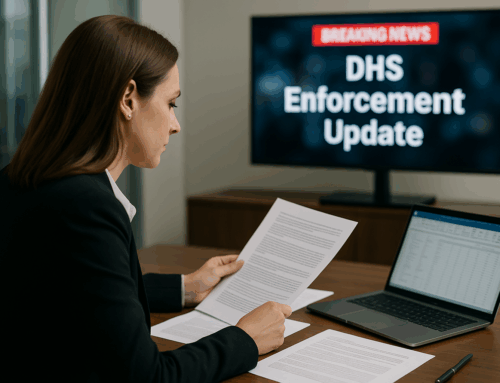When a European tech company rushed to establish its first U.S. office, immigration paperwork was delegated to an outsourced provider. On paper, everything looked fine—until the consulate flagged that the executives listed didn’t meet the “managerial capacity” requirement.
The launch was delayed by months, critical contracts were lost, and HR was left explaining to leadership how a single immigration misstep derailed the strategy.
This is exactly the type of scenario discussed in Nadalin Law’s recent LinkedIn Live session on Immigration Options for New U.S. Offices.
For HR leaders and Legal Ops teams, immigration isn’t just compliance. It’s a business-critical function that can make or break your expansion timeline.
The Corporate Immigration Expansion Checklist
Based on common pitfalls and best practices, here’s the framework every HR team should run before opening or expanding a U.S. office:
1. Clarify Visa Strategy for Key Roles
- H-1B: Good for specialized hires, but subject to the lottery.
- L-1A/B: Strong for intracompany transfers, but requires strict executive/managerial definitions.
- O-1 or EB-1A: Ideal for “superstar” employees with extraordinary ability.
2. Plan Green Card Pathways Early
- Don’t wait until year five of H-1B status.
- Consider NIW, EB-1A, or EB-1B to bypass long PERM delays.
3. Secure Compliance Systems
- Track I-9s, expirations, and filings.
- Assign clear ownership inside HR or Legal Ops.
- Audit case management systems quarterly.
Stay ahead on immigration updates — join our newsletter →
4. Build a Mobility Protocol
- Use pre-travel checklists to avoid visa stamp denials.
- Document re-entry requirements for executives and dependents.
- Flag urgent travel to legal counsel early.
5. Establish an On-Call Safety Net
- Commoditized providers often won’t touch “one-off” questions.
- On-Call+ gives HR direct access to senior immigration counsel when timing or employee wellbeing is on the line.
Reading tip for you:
How a Qualified Candidate Lost a U.S. Visa Stamp in 60 Seconds — and How to Avoid It
Why HR Leaders Need More Than a Commoditized Provider
Most large providers operate like ticketing systems: cases move through a queue, but nuanced questions get sidelined. That might work for routine renewals, but it falls apart when:
- A leadership hire doesn’t fit neatly into the H-1B box.
- An investor needs expedited options.
- A spouse’s travel plans collide with visa stamp timing.
Nadalin Law’s approach is different: high-touch, attorney-led, and built around HR’s real-world pressures. Clients don’t just get filings—they get a trusted partner who answers questions in real time and plans ahead for workforce growth.
Key Takeaways
- Immigration = Business Risk. A delayed approval can stall hiring, expansion, and revenue.
- Checklists = Confidence. HR can brief executives clearly and avoid surprises.
- High-Touch = Insurance. Having a partner who will pick up the phone can save weeks of disruption.
Stay ahead on immigration updates — join our newsletter →
Frequently Asked Questions (FAQ) on U.S. Office Immigration
1. What is the most common visa for opening a new U.S. office?
The L-1 visa is the go-to option for intracompany transfers of executives, managers, or employees with specialized knowledge. To qualify, the employee must have worked at least one year abroad with the sending company, and the U.S. affiliate must be properly established.
2. Can we use a virtual office address for immigration filings?
It’s possible, but risky. U.S. immigration officials often look for a physical office lease to confirm the company’s legitimacy and reduce fraud concerns. While some approvals happen with virtual addresses, the chances of denial increase significantly without a physical premises.
3. What’s the difference between an L-1 visa and EB-13 multinational manager green card?
- L-1A visa: Temporary, for executives/managers transferring to a U.S. office.
- EB-13 green card: Permanent residence pathway, but the U.S. office must already be established and active for more than one year.
4. How early should HR plan for green card sponsorship?
Ideally, from day one of U.S. employment. Certain categories like the National Interest Waiver (NIW) or EB-1A “extraordinary ability” can bypass the long PERM process, saving years and helping with retention.
5. Are there risks if we transfer too many employees from abroad without hiring in the U.S.?
Yes. Even though not all visa categories require U.S. hires, consulates and USCIS may view a transfer-heavy structure as a red flag. Hiring some U.S. workers strengthens your case and demonstrates long-term commitment.
6. What happens if immigration paperwork isn’t consistent across applications?
Every filing creates a record. If HR describes a role one way in an L-1 petition but differently in a later green card filing, the government will notice and may question credibility. Consistency across filings is critical.
7. What’s the fastest green card option for high-achieving employees?
- EB-1A Extraordinary Ability: Drastically shortens wait times, especially for employees from high-backlog countries like India or China.
- EB-1B Outstanding Researcher: Fast for academics/scientists with strong credentials.
- NIW (EB-2): Flexible, often two years faster than PERM-based green cards.
8. When should HR involve immigration counsel?
As early as possible—ideally before incorporation and office setup. Key decisions like entity type, office address, and staffing plans all affect visa eligibility. Having counsel on board ensures HR doesn’t waste time (or budget) correcting preventable mistakes.
9. What’s the value of Nadalin On-Call+?
When HR leaders get stuck with urgent, one-off immigration questions, large providers often won’t help. On-Call+ gives direct access to senior immigration counsel—no ticketing systems, no runarounds—so HR can resolve issues quickly and avoid disruption.
Contact Nadalin Law to schedule a consultation or learn more by filling out the form below ↓




![Trump’s Proposed 100k H-1B Fee— Robert Nadalin Comments It [Video]](https://nadalinlaw.com/wp-content/uploads/2025/09/D5IX5OYFLZM5RIAFPONOA3I3OM-scaled-e1758647749127-500x383.avif)


